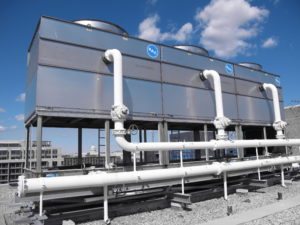
In 2012, the Board of Directors of one Southwest Condominium sat circled in their neighborhood’s Thelma Martin Room, setting some lofty goals to change the dynamic of their processes and direction. The community was Carrollsburg, A Condominium, a historic mid-century modern property that includes 38 garden-style townhomes and three high-rise towers on 11 manicured acres of the District’s Southwest Waterfront.
“We wanted to push the infrastructure of the property well into the 21st century while maintaining the look and feel of the mid-century modern landscape,” said ANC Commissioner and former Board President Gail Fast.
To execute this plan, the Board made a firm decision: when faced with typical reactive, and sometimes myopic, decisions to repair outdated building systems and equipment, the Board would consider only proactive, holistic solutions that looked far out into the future of the community.
Three primary objectives were set around a central vision to balance highly advanced infrastructure with mid-century architecture:
- Improve Operations
- Maximize Returns
- Increase Community Involvement & External Visibility
With these in mind, the 1967 property set out on a path of continuous improvement that would eventually pay dividends and lead to some of the most advanced infrastructure in the city.
“When I started with [Carrollsburg], we had mechanical infrastructure that was taxing the property on all fronts: repair costs, utility bills, engineering labor, everywhere. We had an Energy Star Score that put us in the bottom 25% of similar buildings, but we also had a Board and a Community that was ready for a change,” tells Juan Cooper, President of JVE Services and Carrollsburg’s Director of Engineering.
And change they did. The Board began analyzing financials, soliciting the input of residents, and recruiting the support of local experts. Using their first phase—the replacement of the 500,000 square-foot property’s aged central heating and cooling plant—as the test, they asked several local service providers to identify the most holistic and scalable paths for improvement. The final solution, which included what the board believed to be not only the best option for Phase I but also the best plans for Phase II, was brought to the table by Boland, local HVAC and energy solutions contractor.
“We knew that we needed to merge the property’s operational, financial and social objectives in a way that would look beyond a technical solution. We had to not just address infrastructure, efficiency or cash flow, but also the fact that this was a home to the individuals who occupied Carrollsburg’s 425 residences – one they and we wanted to be proud of,” recalls Mike Cain, Managing Director of Era Building Solutions and, at the time, the face of Boland’s efforts at the property.
The solution incorporated a phased approach to the property’s central plant replacement which would also include “front of the house” upgrades such as lighting improvements and live energy dashboarding to encourage resident participation in the efficiency efforts. Cooling towers, chillers, water heaters, boilers, pumps, air handling units and more were replaced, and advanced infrastructure such as a highly optimized Building Automation System was added.
Then, Carrollsburg took the unusual and innovative step of establishing their own power generation using on-campus microturbine technology. Through this system, the condo uses natural gas to generate electricity onsite, eliminating the typical losses associated with transmission and distribution from a utility’s remote power plant to a building. The waste heat from the process is then recovered and reused to heat the campus’ six structures in the winter, power cooling equipment in summer, and heat water for sinks and showers year-round.
With the property abuzz with improvement, many in the community were anxious to personally participate in the progress. Over 150 residents opted to perform out-of-pocket upgrades to their in-unit HVAC systems to further the energy savings and comfort improvements, and the community voted to replace resident windows throughout the property to maintain architectural appeal, improve comfort and reduce infiltration.
Over 5 years after the start of the improvement efforts, members of the Board and community have changed, but the push for improvement is still as strong as ever. The once low-performance but architecturally-accomplished property is now within 3% of the consumption threshold needed to obtain Energy Star Certification. The current Board is undertaking efforts to fine-tune previous upgrades, and residents are driving improvement by participating in more efficient in-home behaviors.
Since 2012, Carrollsburg has saved an estimated $700,000 in total energy costs – nearly $200,000 of which occurred last year alone. Energy consumption has been reduced so significantly that total emissions savings recently surpassed the equivalent of 10,000 barrels of oil, or over 10,000,000 miles driven by an average passenger vehicle.
“We’ve accomplished some great things over the last 6 years, but we are really looking forward to doing even more in the years ahead,” said William “Luke” Lucas, 41-year veteran of the community’s engineering team.
In an era when residents of some communities struggle to find neighborly common ground, the residents of Carrollsburg, A Condominium seem to have found a balance that works through a mission in which they can all believe and participate: the continuous improvement of their community.
BY Salma Moghisi and Mike C. Cain

